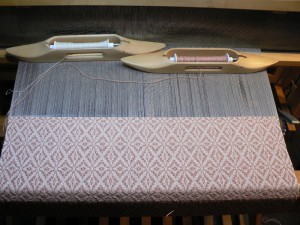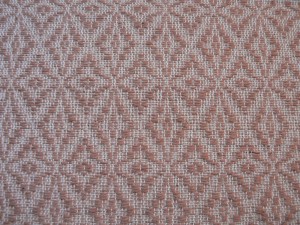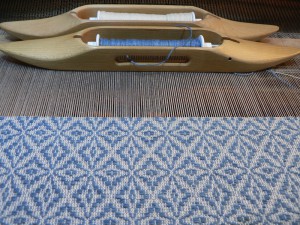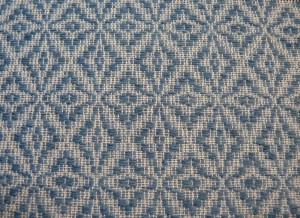My new book cloth is a variation of a miniature overshot motif called Hopvine. To create my threading I worked from two other drafts. One was “Modified Hopvine” from a sampler from the Hill Institute. The other was “Modified Hop Vine” from Marguerite Davison’s classic A Handweaver’s Pattern Book. The threading from Hill had too many ends in each pattern repeat to suit the scale of my book covers (5.5 inches by 8 inches) so I wanted to make the motif smaller. The Davison draft had fewer ends in a repeat but looked weirdly jittery in the drawdown in my weaving software.
So, I tinkered until I found a satisfying balance in the pattern, and am still tinkering with the treadling. The design consists of two different diamonds, one a longer and more pointed and the other a little more squat and rounded. I am not sure if these are supposed to evoke different elements of a hop vine, for example the leaves and the inflorescences. Or maybe the name of the pattern has a different origin. There are some nice images of hops plants here.
For those of you who recall my emboldening tabby travails of a year ago, you might be surprised to hear that I ran into the same problem of keeping a consistent tabby this time, also. Sigh.
The inconsistent tabby problem is due to the fact that I had an odd number of ends at the turning points in the pattern. I foolishly didn’t bother to check this. After I settled on a threading that I liked, I just derived the treadling based on the twill pairs in the threading. Then I counted the total number of picks in a repeat, and since that was even, I figured my tabby would stay consistent. I actually think the cloth looks very nice anyway, but I have figured out a new treadling that should solve the problem, and will see what difference it makes in my next piece of cloth.
Here is a portion of cloth on the loom using woad-dyed 22/2 cottolin pattern yarn and natural 20/2 warp and tabby weft.
Here’s a piece with a madder-dyed 22/2 cottolin pattern weft.

 Because both of these pattern wefts are a little thicker than 10/2 cotton, the motifs are slightly elongated. I don’t mind this and I think the proportions are elegant.
Because both of these pattern wefts are a little thicker than 10/2 cotton, the motifs are slightly elongated. I don’t mind this and I think the proportions are elegant.
Unlike my last batch of books, I don’t plan to weave all of these with naturally dyed pattern weft yarns. So, some will be woven with commercial 10/2 cotton and 10/2 and 8/2 tencel, and these will presumably be more square.
Here are two photos showing two different ways to center the motif when cutting the cloth for the book covers. In one I decided to cut through the middle of a diamond, and in the other I cut at the edge of the diamond.

 I glued one pair of boards each way so that even though they will be made with the same yarn, each book will be unique.
I glued one pair of boards each way so that even though they will be made with the same yarn, each book will be unique.


